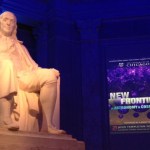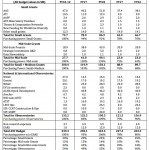astro
Continued slow liveblog of the New Frontiers in Astronomy and Cosmology Conference at the Franklin Institute.
Lunch is almost over and we are headed into the final session of research presentations, clearly saving the best for last...
I am also reminded why we have these meetings, in person, the chats during break and back and forth in sessions provides very dense information transmission and tight feedback loops on news.
Big Question IV - Are we Alone in the universe?
Or, are there other life and intelligence beyond the solar system?
1) Jonathan Lunine from Cornell on "The search for life…
Continued slow liveblog of the New Frontiers in Astronomy and Cosmology Conference at the Franklin Institute.
We have had coffee and we are rested and ready after yesterdays 14 hour marathon session (graduate students please note - though it did include breakfast, lunch, dinner and two coffee breaks ("working breaks" natch, apart from the hour+ break before dinenr) - and I don't think any of the faculty could actually keep it up for more than 2-3 days, except in our imagination ('course we then went back to the hotel and had to catch up on class and administrative issues left unattended, but…
The second session of the New Frontiers in Astronomy and Cosmology conference was friday afternoon.
The plan was to do a leisurely liveblog of the talks.
However, during lunch, there were some interesting developments, which I can hopefully tell you about next week some time, and in the middle of the discussion I was told that I was the session chair for the afternoon and we were starting in two minutes.
And a brilliant session it was too.
But as chair it was a bit hard to take notes and blog it live...
So you get the tape delayed version, editors cut, instead:
We continued after lunch with…
A slow liveblog of the conference.
The New Frontiers in Astronomy and Comsology is having its awards conference at the Franklin Institute in Philadelphia.
The 20 odd winning researchers and research groups are presenting summaries of their proposed research, to be followed in a couple of years with another conference in Chicago where they will, hopefully, present their results.
The high school and college essay winners are also here to receive their awards and schmooze with the random astroboffins.
I plan to do my usual intermittent blogging of the presentations, time permitting.
The list…
Or, how may hours should graduate students work?
Well, depends...
However Many You Like
As Many As They Can
As Many As Are Needed
All Of Them
The answer may sometimes lie in the above range, sometimes may be somewhat less, and occasionally even more.
We've all been there, and all suffer from survivor bias, confirmation bias and not a little survivor's guilt.
The occasion of course, is The Letter very helpfully sent to all the astronomy graduate students at a distinguished research university by a well intentioned distinguished faculty member.
It is causing quite the buzz in astro social…
In which we win an award from the New Frontiers in Astronomy Program.
The New Frontiers in Astronomy and Cosmology program announced its research grant award winners yesterday.
The last, but not least of the Big Questions solicited in the Call for Proposals, was:
Are we alone in the universe? Or, are there other life and intelligence beyond the solar system?
There were four awards in this "Astrobiology and SETI" category, focusing on different approaches in the search for life elsewhere in the Universe.
We got one:
"Constraining the Abundance of Kardashev Type II and III Civilizations From…
The New Frontiers in Astronomy and Cosmology program included 20 awards for 2 year research projects on Big Questions.
The winners are:
Big Question I
What was the earliest state of the universe?
Detecting Cosmic Superstrings
David Chernoff, Cornell University
Co-Investigator: Henry Tye, Hong Kong University of Science and Technology
CosmoArchaeology: Digging for the Initial State
Richard Holman, Carnegie Mellon University
Co-Investigators: Shirley Ho, Carnegie Mellon University; Sarah Shandera, The Pennsylvania State University; Nishant Agarwal, Carnegie Mellon University; Ross O’Connell…
The New Frontiers in Astronomy and Cosmology program included 21 awards for essays by high school and university students on the Big Questions.
The winners are:
Student Essay Competition
College Essay Winners
First Prize
Yong Wei Chong Gabrielle, Wellesley College,
"A Letter to My Dearest Newborn Baby Brother"
Second Prizes
Karl Haislmaier, George Mason University,
"The Emergence of Complexity in the Universe as Viewed from a Holistic Perspective"
Patrick Olden, University of St. Andrews,
"How can we know the complex?"
Third Prizes
Annette Hein, Casper College,
"The Observer's Eye: Human…
The New Frontiers in Astronomy and Cosmology program has
announced its Award winners!
The $4+ million in awards went to 20 scientists studying Big Questions on fundamental issues and 21 high school and university student essay prize winners.
The awards will be presented at a conference at the Franklin Institute in Philadelphia next week.
The program is funded by the Templeton Foundation as part of its celebration of the centennial of the birth of its founder, John Templeton.
The topics solicited for the Big Questions were very interesting:
What was the earliest state of the universe?
What…
“If... then my old theory is completely toast,” says astrophysicist Steinn Sigurdsson of Pennsylvania State University. “This is a really nice piece of work.”
Nice Nature paper coming out tomorrow by Jay Strader et al
on a pair of flat spectrum ultra-faint radio sources in the core of M22.
The sources are consistent with being ~ 20 solar mass black holes, accreting at a low rate from, well, something.
Maybe...
Best candidates yet in the Milky Way globulars.
M22 has a somewhat unusual structure (massive fluffy core) in a way that several authors have suggested might be a signature of black…
Postdoctoral Scholar, Stellar and Exoplanetary Astrophysics and SETI
"Applications are invited for a postdoctoral research associate position to work with Prof. Jason Wright and collaborators.
The ideal applicant will have some combination of:
• experience working with large photometric datasets, especially in the near and mid-IR
• strong coding skills, in languages including IDL
• the ability to independently solve novel research problems, including the application of results from unfamiliar fields
• a desire to work with and assist in advising graduate and undergraduate students;
• a…
Applications are invited for a postdoctoral scholar position to work with Prof. Mike Eracleous and collaborators. The successful applicant will join a team working to identify close, supermassive binary black holes through a combination of observational tests. The postdoctoral scholar will be expected to plan and carry out observations related to this project and lead the effort of analyzing the data and publishing the results.
A Ph.D. in astronomy, physics, or a related field is required, and research experience on active galactic nuclei is highly desirable. In addition, experience with the…
The OMB has reported on the effects of sequestration that will be triggered Jan 2013 unless Congress proactively changes the law before then.
Some time ago, Congress set itself a trap: in an attempt to look like they were dealing with government spending and the deficit, they passed a law that triggers automatic cuts to spending, unless Congress agrees and passes laws that make concomitant targeted cuts or revenue increases to decrease the deficit.
The nominal cuts are about $1.2 trillion, over a decade, cut from the projected budget in the out years, and are, by design flat across-the-board…
Anyone want to buy some telescopes?
Heavily used.
Free to a good home.
The NSF has issued a preliminary response to the NSF Astronomy Portfolio Review.
Game on.
NSF MPS/AST Response to Portfolio Review Report (pdf)
This is a 4 page response from NSF Astronomy Division Director Ulvestad to the Portfolio Review, from August 31st 2012.
Implementation is pending current budget negotiations for next fiscal year budget and plan.
Implementation requires acting by end of 2013.
Small Grants: "...Given the constrained budget scenarios and the explicitly higher-priority recommendation for AAG and…
Heads up, peeps.
NSF Portfolio Review is out
Mayall, WIYN, 2.1m KPNO, GBT and VLBA are out in recommended scenarios.
Shit.
Portfolio Review - full text 170 pp (pdf)
To summarise: Kitt Peak telescopes cut; Green Bank Radio Telescope and Very Large Baseline Array cut; McM-P Solar Telescope cut before Advanced Solar Telescope starts.
Committee recommends pre-emptive cuts based on pessimistic budget scenario.
LSST, CCAT and GSMT in.
Two scenarios:
A presumes 10% effective cut over decade
B presumes 30% effective cut over decade
From Exec Summary: "We recommend that AST avoid the risk of…
Continuing slow live blog of the “New Particle Physics at the LHC and Its Connection to Dark Matter” workshop at the Aspen Center for Physics.
Series of short talks this morning:
"A WIMPy Baryogenesis Miracle" by
Yanou Cui, Lisa Randall, Brian Shuve (arXiv:1112.2704) interesting and possibly useful speculation on how electroweak scale WIMPs could couple to normal matter in early universe and actually generate some or all of the normal matter, in particular in such a way as to generate the observed matter/anti-matter asymmetry.
Aside: Quantum Diaries has the down and dirty details of the Higgs…
Mining the Astronomical Literature - yes, just ADS not the Asteroids, yet.
Shamelessly cribbed from a thread on the fb Astronomers group
In defence of string theory - rather good post by Matt Strassler
Claim that founding node of networks can be efficiently localized by sparse sampling
Don't Confuse Technology With College Teaching - from the Chronicle
Kepler 11: A Six-Planet Sonata from Alex Parker on Vimeo.
"New Particle Physics at the LHC and Its Connection to Dark Matter" is the name of the current workshop at the Aspen Center for Physics running through Sep 9th.
I'm hanging out for the first few days and the first presentation is on "what has the LHC Higgs done to supersymmetry"?
So, basic point is that supersymmetry sort of predicts that the Higgs mass (125 GeV) should be close to the Z mass (91 GeV), up to some corrections. So the mass corrections can be parametrised in perturbative theory, and how do you nail a ~ 30% correction and keep everything natural?
We talk about our feelings.
We…
Last talk of the LHC Shows the Way workshop, with the most provocative title.
Entries in this post may or may not be mangled misrepresentations of stuff the speaker made up just to be provocative...
Starting point: there is something at ~ 125 GeV and it is consistent with a boson, possibly a scalar, and quite likely a standard model Higgs boson.
Agreed.
Preliminary results for CMS experiments show branching ratio to ττ decay mode a little bit lower than normal.
ATLAS initially did simple crude analysis of this channel.
Now redone with more data and better technique.
ATLAS expect to make…

